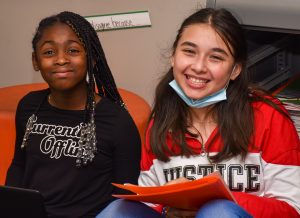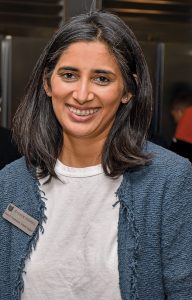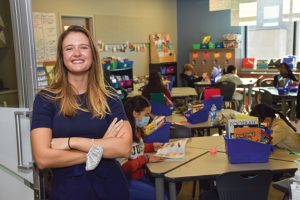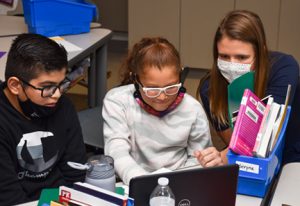Community Schools pay huge dividends in suburban Union

As school buildings go, Ellen Ochoa Elementary looks like many modern schools being built these days in suburban Oklahoma towns. Lots of natural light filtering into the classrooms. Interesting design lines inside and out. Happy students going about their daily routines.
The first hint that Ochoa is something else altogether is the other building sitting on the campus. It’s a health clinic and it’s not a separate entity that just happened to plop down next to a school. The clinic is part of the school and sits on the campus intentionally, serving the students of Ochoa, their families and even community members with no direct connection to the school other than living within its attendance boundaries.
What’s not so obvious to the casual passer-by is how much the community as a whole is involved at the school.
Ochoa is found on the northern edge of the Union Public School (UPS) district, just across the street from the Tulsa Public Schools district. Ochoa has nearly 1,000 students, mostly Hispanic but very diverse. About 90% of its students qualify for free and reduced meals, and most are bilingual.
All of the students at Ochoa and their families live within a mile-and-a-half of the school.
UPS considers all of its sites to be community schools, but eight elementaries are “full-service community schools.” Ochoa stands out as the model, providing wrap-around services fully immersed in helping its surrounding community.
Defining Community Schools

The concept of community schools may not be well-known outside of education circles, or even outside of the Union district. But they can be found all over the country with a proven track record of transforming low-performing schools.
In Austin, Webb Middle School had a graduation rate of just 48% in 2009 and was on the verge of closure. By 2016, it was the highest performing Title 1 school among the district’s 14 middle schools with a 90% graduation rate.
In 2000, Cincinnati had no community schools and 85% of its students dropped out by the end of the 10th grade. After turning 44 of its 65 sites into community schools, the district jumped to an 80% graduation rate with 40% of its students going to college.
After adopting the community schools model, Hillsborough, Florida, schools saw student suspensions drop 69% in one elementary and 34% at a middle school.
Kulsum Siddiqui, Union’s district school liaison for community schools, sums up the model rather simply: “You can’t help students without helping their families.”
Community schools are built on six pillars:
- Strengthened curriculum and academic programs that are culturally relevant and engaging.
- An emphasis on high-quality teaching.
- Coordinated and integrated wrap-around supports, such as health care, eye care and social and emotional services.
- Positive behavior practices such as restorative practices.
- Transformational family, student and community engagement.
- A shared leadership philosophy.
What is really exciting about this model – especially for policymakers – is that it doesn’t need another penny of tax money to be implemented or to be successful. Partnerships with local businesses and nonprofits help fund the variety of services and programming.
Union's Path to the Community Schools Model

Poverty levels were at 15% in the Union district in 2000, with a student body comprised mostly of white students. About that time, teachers started seeing a deep shift in their student demographics. Today, the poverty level is 70% and UPS schools have a much more diverse student population than it did just 15 years ago.
As the district demographics began to change, UPS administration realized that it must embrace the new diversity.
“When we see a student who is on the cusp of learning English, we don’t see that as (an obstacle),” said Siddiqui, a 2000 graduate of Union High School. “We see that as, ‘This kid is bilingual. This kid is going to have a bright future because he can speak English and Spanish.’”
Moving to a community school model required a new mindset and a willingness to find innovative ways to help students be successful not just in school but in life later on. The idea that school was 8 a.m. to 3 p.m. September through May was not good enough. After-school programming was a must and the school building needed to be open in the summer.
Siddiqui said a survey of parents found that 75% of students did not participate in any enrichment program outside of school. The No. 1 reason was cost, followed by transportation and parent schedules.
Today, enriched after-school programming is a hallmark at Union’s eight full-service community schools. Roy Clark Elementary was first, in 2005. Next came Boevers, Grove, Jarman, Jefferson, McAuliffe, and Rosa Parks elementaries. The newest elementary, Ochoa, was built in 2017 with the community school model in mind. Each school conducts an annual needs assessment with its families to determine afterschool programming.
“Community schools is not a cookie-cutter approach. It looks different in every school,” Siddiqui said.
The programs are open to all students, serving about 3,000 students pre-pandemic. Each site’s after-school program runs Monday through Thursday for an hour-and-a-half to two hours, September through May. Every child receives a snack and transportation home. The programming looks different at each site. It could feature STEM, fine arts, youth development, health and wellness or coding – whatever appeals to that individual school community.
Run Club has been a very popular after-school program. During the pandemic, UPS offered a virtual run club, giving students a log in which to track their progress. If they completed 26.2 miles over an eight-week period, students received a medal for completing a marathon.
Partners like Camp Fire, Girls Scouts and Tulsa Changemakers provide programming at no cost. Other programs like visiting the Tulsa Children’s Museum or hobby-based clubs need funding. Siddiqui, who finds herself spending more time fund-raising, assures corporate sponsors that their money will be used for programming only. Nonprofits provide food and clothing.
Ochoa Takes Community Schools to the Next Level

Fifth-year teacher Hannah Jarman is in her third year teaching fourth grade at Ochoa. She came to Tulsa as a Teach for America educator after receiving an undergraduate degree from the University of Illinois Urbana-Champaign.
She spent her first two years teaching in a charter school that accepted students from around the city. Teaching at Ochoa is an entirely different experience.
“You just really get that sense of physical community,” she said of Ochoa. “You get to walk into the neighborhood and see all your families outside and there’s also the welcoming experience of having parents come into the building. Even from my first year here to now, I’ve seen the sense of community grow so much.”
The on-site health clinic is run by Community Health Connections. Funding to build the clinic came from the City of Tulsa. It provides a wide variety of health care, including nutrition and dental screenings, for all residents in the Ochoa boundaries. Students also have access to mental health services separate from the health clinic.
Ochoa Elementary includes a community kitchen and a space dedicated to a neighborhood garden. There is a room used for after-school community events, like tax preparation seminars, that is accessed without entering the school.
Even building the school included input from the entire community. The students wanted an indoor slide, so a shiny, metal, two-story spiral slide sits in the middle of the building.
“Everyone plays a role in a community school,” Siddiqui said. “So, you’re looking at all of the different stakeholders in a small community and what does every single person need and how can we have those wrap-around services to ensure that not only are students getting what they need but how can we support the families to help students as well.”
Following Through on the Concept

Union’s philosophy of helping students be successful by removing all obstacles is foremost, all the way through high school.
“Union’s mission is pretty simple: 100% graduation, college and career ready,” Siddiqui said. “It’s simple, but very ambitious.” That goal is embraced by everyone from the superintendent’s office to the faculty, from the support staff to the students.
The high school football program is a perennial contender for a state championship in Oklahoma’s largest class. The team has 200 players in uniform because there are no cuts – everyone who wants to play is on the team. The co-curricular model is followed for all high school activities, from sports to band to drama.
“About 90% of our high school students are engaged in some kind of co-curricular activity,” Siddiqui said. “If a kid is engaged in one extra-curricular activity, the chances for graduation are much greater.”
The district established the Career Connect Department after realizing its students were graduating but not going on to college or getting jobs making a living wage. The program connects students to a variety of industries, including automotive, health care and childcare. Juniors and seniors are assigned different internships in the community, and the participating companies wind up hiring those students after they graduate.
“Union Schools provides transportation (to the internships). We provide steel-toed boots if that’s what’s needed,” she says. “Removing barriers for students is a priority for the district.”
For students looking to attend college, Union established a partnership with Tulsa Community College. Each year, a cohort of students who reflect the district’s population take college courses at Union High School. When they graduate, they not only have a high school diploma, but also an associate’s degree.
From after-school programs at the elementary level to college and career programs at the secondary level, Union Public Schools is removing obstacles through the community schools model. The results speak for themselves.
